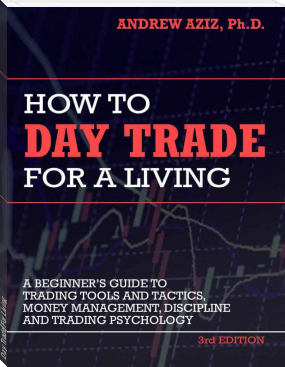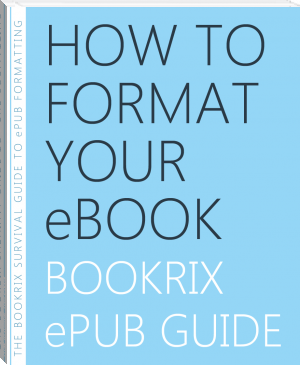Day Trade For Living by Andrew Aziz (epub ebook reader txt) 📕

Read free book «Day Trade For Living by Andrew Aziz (epub ebook reader txt) 📕» - read online or download for free at americanlibrarybooks.com
- Author: Andrew Aziz
Read book online «Day Trade For Living by Andrew Aziz (epub ebook reader txt) 📕». Author - Andrew Aziz
AAPL Daily Chart for Summer 2016. Days that AAPL had a significant relative volume are ma rked. Those days were suitable for day trading AAPL.
Take a look at the AAPL daily chart for the summer of 2016. As you can see, there were only two days that had high relative activity. They're
marked with arrows on the chart. Interestingly enough, when you take a close look at the chart, you realize that on those days the stock gapped up or down. I marked those price gaps in the chart. If you wanted to trade AAPL, you should have traded it only on those days. The other days were comprised of just normal, high frequency, algorithmic trading. Retail traders should stay away from stocks that are trading normally.
The most important characteristics of high relative volume stocks is that these stocks trade independent of what their sector and overall market are doing. When the market is weak, it means that the majority of stocks are selling off It does not matter if it is Apple, Facebook, Amazon or Exxon. When the market is strong, the prices of the majority of stocks will be going higher. Similarly, when you hear someone say the market is "bear" or "collapsing," they don't mean a specific stock. They mean that the whole stock market is losing its value - all stocks together. The same is true for specific sectors. For example, when the pharmaceutical sector is weak, it means all of the pharmaceutical companies are losing their values together. How do you recognize behavior of market? Index funds such as the Dow Jones Industrial Average (DJIA) or the S&P 500 (SPY) are usually good indicators of what the overall market is doing. If the Dow Jones or the SPY are red, it means that the overall market is weak. If the Dow Jones or SPY are strong, then the overall market will be going higher.
The behavior of stocks that have high relative volume is independent of the overall market. Every day, only a handful of stocks are being traded independently of their sector and the overall market. Day traders trade only those stocks. I call those stocks "Alpha Predators". In the animal kingdom, an alpha predator is a predator at the top of a food chain upon which no other creatures prey. In day trading, Alpha Predator stocks are the ones that are independent of both the overall market and their sector. The market cannot control them.
Therefore, the next rule is about Alpha Predators;
Rule 7: Retail traders trade only Alpha Predators , high relative volume stocks that have fundamental catalysts and are being traded regardless of the overall market.
What makes a stock an Alpha Predator? Usually it is the release of fundamental news about the stock either the day before or during the same trading day. Important news or events for companies can have huge effects on their value in the market and therefore act as fundamental catalysts for their price action.
As mentioned in Chapter 2, some examples of the fundamental catalysts for stocks that make them suitable for day trading include:
Earnings reports
Earnings warnings/pre-announcements
Earnings surprises
FDA approval/disapproval
Mergers/acquisitions
Allia nces/partnerships/maj or product releases
Major contract wins/losses
Restructuring/layoffs/management changes
Stock splits/buybacks/debt offerings
In Chapter 7, I explain specific day trading strategies such as Momentum, Reversal, VWAP Strategy and Moving Average. For the moment, your main question is, how do I find the stock for each strategy? I categorize stocks for retail trading into three classes. Based on my experiences, this categorization provides some clarity on how to find stocks and on how to adopt a strategy for them. You will find other categories elsewhere, and some of my fellow day traders will disagree with my categorization, saying, with some justification, that it is very simplified.
Before explaining the three categories, let me explain the definition of "float" and "market capitalization" or "market cap". Float means the number of shares available for trading. Apple Inc. for example, as of July
2016, had 5.3 billion shares in the market that are available for buying and selling. Apple is considered a "Mega Cap" stock. These stocks usually don't move much during the day because they require significant volume and money to be traded, so Apple shares might on average change by only one or two dollars each day. They are not very volatile and therefore day traders don't like trading them. Day traders look for volatility.
On the other hand, there are some stocks that have very low float. For example, Cesca Therapeutics Inc. (ticker: KOOL) has only a 1.2-million share float. This means that the supply of shares of KOOL stock is low and therefore a large demand can very quickly move the price of the stock. Low float stocks can be volatile and move very fast. Most of the low float stocks are under $10 because they are early stage companies which for the most part are not profitable. They hope to grow, and by growing further, they issue more shares and raise more money from the public market and slowly become mega cap stocks. These low float stocks are called small cap or micro-cap stocks. Day traders love low float stocks.
Now let's return to the three categories I had just mentioned . The first category consists of 1ow float stocks that are priced under $10. These stocks are extremely volatile, moving 10%, 20%, 100% or even 1000% a day. Yes, there have been these kinds of moves! You must be careful with this category. Just as you can turn your $1,000 into $10,000 in a single trade, your $1,000 can easily turn into $10. Low float stocks under $10 are often highly manipulated and difficult to trade, and therefore only very experienced and highly equipped retail traders should trade these stocks. I personally rarely trade in them. If someone claims to have turned $1,000 into $10,000 in a month, and if it 's true, they must have traded this type of low float stock. No beginner or even intermediate trader can trade with such accuracy and efficiency. If novice traders tried trading low float stocks that are under $10, they would more likely turn their $1,000 into nothing in a matter of days.
When it comes to low float stocks, the Bull Flag Momentum Strategy - which I detail in Chapter 7 - works best. The other strategies in this book are not suitable for low float sub-$10 stocks.
You generally cannot sell short low float stocks that cost less than $10. For short selling, you need to borrow shares from your broker, and it 's rare that a broker will lend you such volatile stocks. Even if your broker is willing to lend them to you, I strongly advise that you do not attempt to short sell them. They can easily surge and you will end up wiping out your account. You definitely can become a full-time profitable day trader without short selling risky stocks, so leave that to the Wall Street professionals.
The second category is medium float stocks in the range of $10-$100. These stocks have medium floats of around 5 million to 500 million shares. Most of my strategies explained in this book work well on these stocks, especially the VWAP and Support or Resistance Strategies. Medium float stocks that are more expensive than $100 are not popular among retail day traders and I myself avoid them. You usually cannot buy many shares of them because of their high price. Therefore, it is basically useless to day trade them. Leave them for the institutional traders.
The third category of stocks for trading is mega cap stocks like Apple, Ali Baba, Yahoo, Microsoft and Home Depot. These are well established companies that usually have over $500 million in shares outstanding available for trading. These stocks are traded in millions of shares every day. As you may guess, these stocks move only when large institutional traders, investment banks, and hedge funds are buying or selling large positions. Retail traders like us, who typically trade 100 to 1,000 shares, usually cannot move the price of these stocks. Retail traders should avoid these stocks unless there is a good fundamental catalyst for them. From the strategies set forth in Chapter 7, Reversals and Moving Average Strategies usually work well on these stocks. Do not forget though, unless there is a fundamental catalyst, these stocks are being heavily traded by computers and high frequency traders and are not suitable for retail day trading.
The table below summarizes these categories:
Float
Price Range
My Favorite Strategy (Chapter 7)
Low float
(less than 5 million)
Under $10
Only Momentum (Long)
Medium float
(5-500 million)
$10-$100
All, mostly VW/P and Support or Resistance
Large floats
(+500 million)
Any
(usually +$20)
All, mostly Moving Average and Reversal
Finding Trades
Trades can be found in two ways:
pre-market morning watch list
real time intraday scans
Let me explain how each day I find Alpha Predators for trading.
I use my scanner every morning and program it to find stocks suitable for my day trading based on the following criteria:
Stocks that in the pre-market gapped up or down at least $1
Stocks that have traded at least 50,000 shares in the pre-market
Stocks that have an average daily volume of over I million shares
Stocks that have Average True Range of over 50 cents
There is a fundamental catalyst for the stock Why these criteria?
When there are some fundamental catalysts, there will be unusual pre market activity. Stocks gap up or down before the market opens with a significant number of shares being traded (such as 50,000 shares). I look for highly traded stocks, so that buying and selling 1,000 shares won't be a problem. That is why I am looking at stocks with an average daily volume of over 1 million shares. I also am looking for stocks that usually move in a good range for trading. That is why I look at Average True Range (ATR). ATR means how large of a range a stock has on average every day. If ATR is $1, then you can expect the stock to move around $1 daily. That is a good number. If you have 1,000 shares, you may profit $1,000 from the trade. But if ATR is only 10 cents, then the trading range is not att racti ve for me.
Let's look at an example of how my watch list will form. On August 19, 2016 at 9 a.m. (Eastern time), my scanner showed these stocks:
My Gappers watch list on August 19, 2016 at 9 a.m. EST.
As you can see, I have highlighted the Gap% and Float columns on my watch list. From over 4,000 stocks, I now have only nine candidates. I will go over each of them before the





Comments (0)